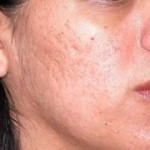
When evaluating acne scars, there are three main types based on their shapes. Ice pick scars are the most common acne scar and are semi-round in shape but narrow and deep. They occur most commonly on the nose and cheeks. Rolling hill scars are wide deep scars that roll into the skin. They often occur in bunches and are the result of large and deep cysts. Boxcar (atrophic) scars are somewhat similar to ice pick scars but are not as deep and are wider. The morphology of acne scars goes a long way in determining the correct treatment choice.
The options available for acne scar treatments include injectable fillers, subcutaneous incision/subcision, punch excision, punch elevation and fractional laser resurfacing. Which of these approaches is best? Again, the shape and depth of the acne scar is the determinant.
Hyaluronic acid injectable fillers work by lifting up the depth of the scar depression and trying to make it more level with the surrounding unscarred skin. In essence, try and raise the valley to get closer to height of the surrounding mountains. Fillers may stimulate collagen regeneration in the skin but this is more theoretical than ever actually seen on a consistent basis. This acne scar technique works best for broad and shallow scars. Deep pitted scars are too fibrotic to be elevated by the push of a filler. While the improvement occurs immediately with injectable fillers, it is a temporary effect that will last as long as the composition of the filler.
Subcision is a technique that inflicts injury to the skin at the base of the scar. This causes the scar to release and accumulate blood underneath it. This is done by using the beveled edge of a small needle like a miniature scalpel. This will result in some bruising and swelling. The dermal collagen injury and bleeding may act as a stimulant for new collagen growth. This technique works best in rolling hill type scars. Multiple sessions are often needed for the best results.
Punch excision is a very well known acne scar technique that does exactly what it describes, it cuts the scar out in a circular pattern. This is done using punches which are small cooker-cutter tools with varying diameters. (1 to5mms) Once the scar is removed, the circular hole is then treated by one of two closure techniques, small suture closure or the hole is filled in with a full-thickness skin graft of the exact size usually cut with the same tool. (punch elevation) Once healed, laser treatments are often done for the smaller scars left behind from excision and closure or the raised scars from the punch graft. Punch excision works best for ice pick and boxcar scars.
Laser resurfacing works best for the most number of acne scar types. The laser fundamentally works by removing the top layer of skin so that shallow scars may be eliminated and deeper scars appear more shallow. But in a 100% ablative laser, where top layers of skin are removed in even unscarred skin, no net gain may often be seen. The better technique for acne scars is fractional laser resurfacing where just a portion of the skin is treated but the penetration is much deeper. The deep skin channels cut by the fractional laser stimulates the skin to contract and get tighter, narrowing the diameter of the scar. Multiple fractional laser treatments are almost always needed.
The challenge of improving facial acne scars is met with a variety of treatment techniques. While perfectly smooth skin is never possible, mixing and matching several of these treatment techniques almost always provides visible improvement for most patients.
Dr. Barry Eppley
Indianapolis, Indiana


